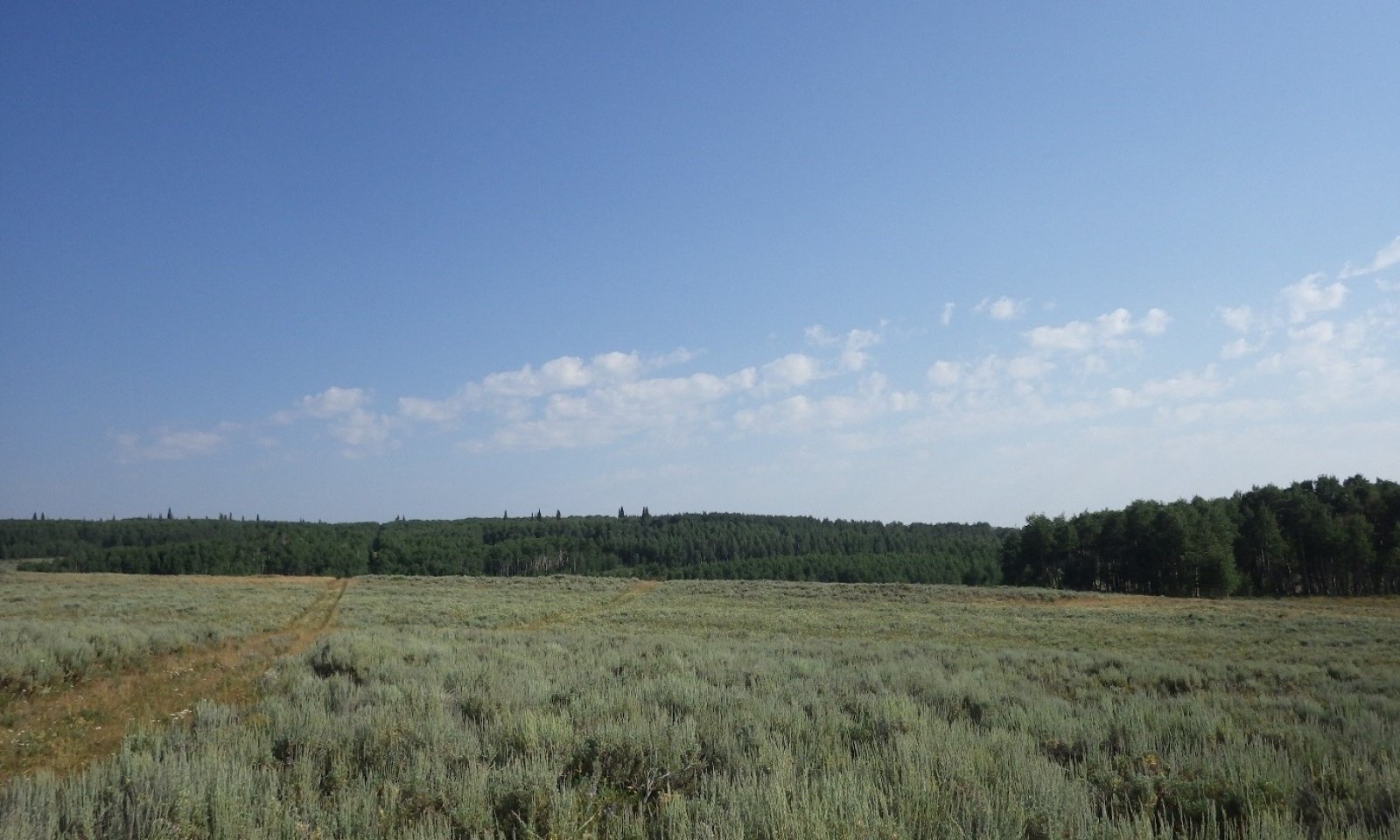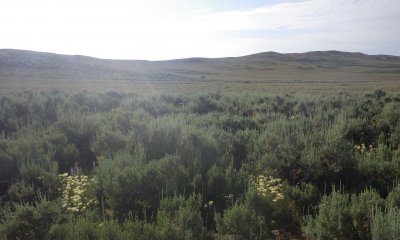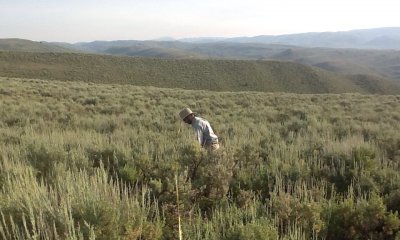
Loamy Wyoming Front
Scenario model
Current ecosystem state
Select a state
Management practices/drivers
Select a transition or restoration pathway
- Transition T1A More details
- Transition T1B More details
- Restoration pathway R2A More details
- Transition T2B More details
- Transition T2C More details
- Restoration pathway R3A More details
- Transition T3A More details
- Transition T3B More details
- Transition T4A More details
- Restoration pathway R5B More details
- Restoration pathway R5D More details
-
No transition or restoration pathway between the selected states has been described
Target ecosystem state
Select a state
Description
The Reference State consists of two Plant Communities: the Sagebrush/Bunchgrass Community (1.1) the Bunchgrass/Sagebrush Plant Community (1.2). Each community differs in percent composition of bunchgrasses and percent woody canopy cover. Forbs are a minor component on this site. Woody canopy cover is less than 30 percent.
In the Wyoming Front LRU, the Loamy site has the highest productivity potential of all upland sites because of high available water holding capacity and low amount of coarse fragments. With high amounts of winter snow, these soils retain soil moisture longer than other sites during seasonal dry periods in the late summer months. The diversity in plant species allows for drought tolerance, and natural plant mortality is very low. These plants have strong, healthy root systems that allow production to increase significantly with favorable moisture conditions.
The dominant shrub species is Mountain Big Sagebrush in the Reference State (1).
Two important processes occurring in this state result in plant community changes within Reference State: sagebrush killing disturbances (fire, browse, insects, and drought) and periods of time without those disturbances. The process of plant community change over time in the absence of disturbance is generally referred to as “natural succession.” Historically, periodic wildfire played the role in removing sagebrush, resulting in an increase in herbaceous vegetation (Wright, 1982). More recently mechanical and chemical treatments have been used as they do not pose a threat of fire escape (Mueggler, 1958). Positive responses in increasing perennial grass production have been shown as a result of mowing dense mountain big sagebrush, although these responses were in the second growing season after treatment (Davies, Bates, & Nafus, 2012).
The shift from Bunchgrass/Sagebrush Plant Community (1.2) to the Sagebrush/Bunchgrass Plant Community (1.1) is dependent on an increase of woody cover. Without sagebrush killing disturbance, shrubs will increase on this ecological site even with proper grazing management. Improper grazing management may accelerate the rate of increase for woody species and/or result in higher shrub canopy cover than in the Reference State.
The shift from the Sagebrush/Bunchgrass or Bunchgrass/Sagebrush Plant Communities is dependent on sagebrush killing disturbances such as fire, drought, herbivory, disease and insect outbreaks. Management actions can and are often used to mimic these processes through mechanical and chemical treatments.
The Reference State is well adapted to the Northern Rocky Mountain Foothills climatic conditions. The diversity in plant species allows for drought tolerance, and plant mortality is low. These plants have strong, healthy root systems that allow production to increase significantly with favorable moisture conditions. Abundant plant litter is available for soil building and moisture retention and is properly distributed with very little movement off-site. This State provides for soil stability and a properly functioning hydrologic cycle. The soils associated with this site hold moderately large amounts of soil moisture, providing a very favorable soil-water-plant relationship. Plant community phases can occur in large contiguous blocks or in a small to large mosaic pattern, but typically this plant community is maintained within a larger mosaic at the landscape level with the other plant communities phases identified in the Reference State (Bukowski & Baker, 2013).
Mechanical and chemical treatment of shrubs have replaced natural sagebrush killing events in many cases. However, some chemical treatments impact nontarget species, particularly broad-leafed species (forbs and shrubs) differently than natural processes. Chemical treatment of sagebrush with tebuthiuron can have impacts the understory, depending on application rate (Wyoming Wildlife Consultants, LLC, 2009). Many historical treatments with continuous grazing both pre- and post-treatment have resulted in a transition to the Disturbed State. Good historical records of the pre-treatment State are not available, but it is presumed that they were already in the Grazing Resistance State, and thus this result may not apply to treatments planned on communities in the Reference State.
Submodel
Description
The Grazing Resistant State is characterized by an herbaceous component dominated by rhizomatous wheatgrasses, Sandberg bluegrass and/or mat-forming forbs, with limited mid-stature bunchgrasses. Once mid-stature bunchgrasses become scarce, it is unlikely there will be sufficient reproductive capability (seed source, tillering, or re-sprouting) to recover dominance in a reasonable time frame without extra energy being added to the system (Cagney, et al., 2010). The plant community is highly resistant to changes in composition, due to the dominance and competition of grazing tolerant species. However, the community can be restored back to the Reference State (1) with sagebrush treatment (chemical, mechanical, or biological brush management) and grazing deferment followed by a grazing system that allows periodic rest during the critical growth period. Seeding maybe needed in some instances to achieve desired results.
Submodel
Description
The Dense Sagebrush State can occur over time with lack of the normal disturbance regime. Mountain big sagebrush is dominant with sagebrush foliar cover >35%. At this level of sagebrush cover in this precipitation zone, there is competition between the shrub over-story and the herbaceous understory (Winward, 2007). The herbaceous understory is largely intact, but forage production for livestock is severely limited in this state. Furthermore, stands with sagebrush this dense are often avoided and hard to walk through. Impacts are often seen to adjacent ecological sites when grazing pressure increases due to avoidance of this site when in this state. This state is “at-risk” for catastrophic fire and transition to the Invaded State (State 4), particularly when occurring homogeneously across the landscape.
Submodel
Description
The Invaded State occurs after the introduction of non-native species that are invasive and dominate the herbaceous understory. Mountain big sagebrush can be either dominant or not, depending on the disturbance regime. There are two plant communities, the Sagebrush/Non-native Plant Community (4.1) or the Non-native Plant Community (4.2).
Common non-native species introduced to this site include smooth brome or Kentucky bluegrass. In the early 1900s, it was common for livestock herders to carry bags of Kentucky bluegrass seed on their saddles and “dribble” seed across the landscape in hopes of improving forage conditions (anectdotal). Some areas that were once farmed during homestead days were planted to smooth brome as a forage grass and then abandoned, with sagebrush eventually returning to the site. In some instances, the disturbance regime was altered with an increase in disturbances, resulting in sprouting shrubs such as rabbitbush or three-tip sagebrush, to dominate.
Submodel
Mechanism
The drivers for transition from the Reference State to the Grazing Resistant State are continuous spring grazing with or without severe drought.
Continuous spring grazing and extended drought can lead to a decline in palatable mid-stature bunchgrasses. Slender wheatgrass, Idaho fescue, bluebunch wheatgrass, Columbia needlegrass, and Spike fescue will decline with grazing pressure and lack of disturbances that kill sagebrush. Letterman’s needlegrass can be an increaser when other mid-stature bunchgrasses have been removed by overgrazing (Natural Resouces Conservation Service, 2007). As bunchgrasses diminish or die during periods of stress, low-stature bunchgrasses and rhizomatous grasses gain a competitive advantage, creating a shift in species composition towards less productive, shorter species. While bare ground may not change significantly, the pattern of bare ground will shift to larger gaps in the canopy and fewer herbaceous plants between shrubs. Many of the remaining desirable bunchgrasses will be only found in the understory of the sagebrush canopy.
Once mid-stature bunchgrass species become scarce, it is unlikely that they have sufficient reproductive capability (seed source, tillering, or re-sprouting) to recover dominance in a reasonable time frame without management changes and extra energy being added to the system (Cagney, et al., 2010). When the understory vegetation has been degraded to this point, the transition to the Grazing Resistant State (2) can occur from either the Bunchgrass/Sagebrush Plant Community (1.2) or the Sagebrush/Bunchgrass Plant Community (1.1). The transition is not dependent on the increase of shrub cover, but rather the lack of mid-stature bunchgrasses in the canopy interspaces.
Management should focus on grazing management strategies that will prevent further degradation. This can be achieved through a grazing management scheme that varies the season of use to provide periodic deferment during the critical growth period (roughly May-June). Forage quantity and/or quality in the Grazing Resistant State (2) may be substantially reduced compared to the Reference State, and will dramatically fluctuate in dry vs. wet years.
Mechanism
The drivers for transition from the Reference State to the Dense Sagebrush State is a lack of sagebrush killing disturbances (mainly fire).
Indicators of this transition include significant increase in sagebrush cover leading to a decline in herbaceous cover or total annual aboveground biomass production falls. The trigger of this transition is total sagebrush cover of >35% and a decline in the understory. Increased shrub cover in this LRU can lead to an increase in fire activity, which can be catastrophic, triggering a transition to the Invaded State (4). Several other key factors signal the approach of a threshold: a decrease in soil surface aggregate stability, and/or evidence of erosion, including water flow patterns, development of pedestals, and litter movement
Mechanism
The drivers for this restoration pathway are reduction of woody species and restoration of native herbaceous species by mechanical or chemical treatment of sagebrush, and grazing rest or deferment. If some mid- stature bunchgrasses remain under the sage canopy, light to moderate stocking with periodic critical growth period rest every 2 or 3 years can move the site back to the Reference State (1) combined with a mechanical or chemical sagebrush treatment. Most probable restoration pathway is from Sagebrush/Mat forb/Bluegrass Community (2.1) to the Bunchgrass/Sagebrush Community (1.2). This could take multiple generations of management or could be accelerated with rest or deferment combined with successive wet springs conducive to seed germination and seedling establishment. (Derner, Schuman, Follett, & Vance, 2014). Seeding may be needed to achieve desired results, if seedbank has been depleted.
Mechanism
The driver for transition from the Grazing Resistant State to the Invaded State (T2B) is the introduction of non-native species and an increase in the disturbance cycle (i.e. fire, drought, mechanical, chemical, biological treatments). Most notable is a catastrophic (very hot) fire event and continuous high intensity grazing. High stocking densities are soil disturbing, and adding sagebrush treatment(s) to this regime result in an increase in the disturbance cycle. Removal of shrubs without proper grazing management can lead to an increase in bare ground and erosion of the upper soil horizon, and the site can degrade to the Invaded State (4). Consequences of this transition are decreased soil fertility, soil erosion, and decrease of soil surface aggregate stability. Indicators of the Invaded state are a shift in shrub dominance away from sagebrush and toward non-native (invading) species such as smooth brome (Bromus inermis) and Kentucky bluegrass (Poa pratensis), and/or sprouting shrubs such as rabbitbrush or three-tip sagebrush.
Mechanism
The driver for transition from the Grazing Resistant to the Highly Disturbed State (T2C) is a topsoil removing event with mechanical equipment. Examples include construction sites, oil and gas activity, and borrow areas.
Mechanism
The drivers for this restoration pathway to the Reference State (1) are reduction of woody species by prescribed fire, mechanical, or chemical treatment of sagebrush, and grazing rest or deferment. Post-treatment grazing management is an important part of site restoration, and 1-2 years of grazing deferment will allow release of the existing herbaceous understory. Periodic rest or deferment are important to maintain productivity, health, and vigor of the plant community and will prevent acceleration of the site from the Reference State (1) to the Grazing Resistant State (2). Allowing the normal disturbance regime (fire cycle) to occur will prevent the site from returning to the Dense Sagebrush State (3)
Mechanism
The driver for transition from the Dense Sagebrush State (3) to the Invaded State (4) is most often catastrophic fire and the introduction of non-native species. Removal of shrubs without proper grazing management can lead to an increase in bare ground and erosion of the upper soil horizon, and the site can degrade to the Invaded State (4). Consequences of this transition are decreased soil fertility, soil erosion, and decrease of soil surface aggregate stability. Indicators of the Invaded state are a shift in shrub dominance away from sagebrush and toward non-native (invading) species such as smooth brome (Bromus inermis) and Kentucky bluegrass (Poa pratensis), and/or sprouting shrubs such as rabbitbrush or three-tip sagebrush.
Mechanism
The driver for transition from the Dense Sagebrush State (3) to the Highly Disturbed State (5)) is a topsoil removing event with mechanical equipment. Examples include construction sites, oil and gas activity, and borrow areas.
Mechanism
The driver for transition from the Invaded State (4) to the Highly Disturbed State (5)) is a topsoil removing event with mechanical equipment. Examples include construction sites, oil and gas activity, and borrow areas.
Mechanism
The Highly Disturbed State (5) is can be restored to the Grazing Resistant State (2) unintentionally when inappropriate seed mixes are used and post-seeding grazing does not provide adequate and periodic critical growth period rest. There is low potential for recovery without significant inputs of energy and resources if topsoil has been removed. Seed mixes that mimic an adjacent “reference area” rather than the site potential as described in the Reference State (1) will often result in a plant community resembling the Grazing Resistant State (2) due to pre and post-seeding grazing management of the area.
Mechanism
The Highly Disturbed State (5) is often restored to the Invaded State (4) if non-native species are used, noxious weeds are not controlled, and/or disturbed areas result in only partial topsoil removal, leaving rootstock available for sprouting shrubs such as rabbitbrush or three-tip sagebrush.
Model keys
Briefcase
Add ecological sites and Major Land Resource Areas to your briefcase by clicking on the briefcase (![]() ) icon wherever it occurs. Drag and drop items to reorder. Cookies are used to store briefcase items between browsing sessions. Because of this, the number of items that can be added to your briefcase is limited, and briefcase items added on one device and browser cannot be accessed from another device or browser. Users who do not wish to place cookies on their devices should not use the briefcase tool. Briefcase cookies serve no other purpose than described here and are deleted whenever browsing history is cleared.
) icon wherever it occurs. Drag and drop items to reorder. Cookies are used to store briefcase items between browsing sessions. Because of this, the number of items that can be added to your briefcase is limited, and briefcase items added on one device and browser cannot be accessed from another device or browser. Users who do not wish to place cookies on their devices should not use the briefcase tool. Briefcase cookies serve no other purpose than described here and are deleted whenever browsing history is cleared.
Ecological sites
Major Land Resource Areas
The Ecosystem Dynamics Interpretive Tool is an information system framework developed by the USDA-ARS Jornada Experimental Range, USDA Natural Resources Conservation Service, and New Mexico State University.








